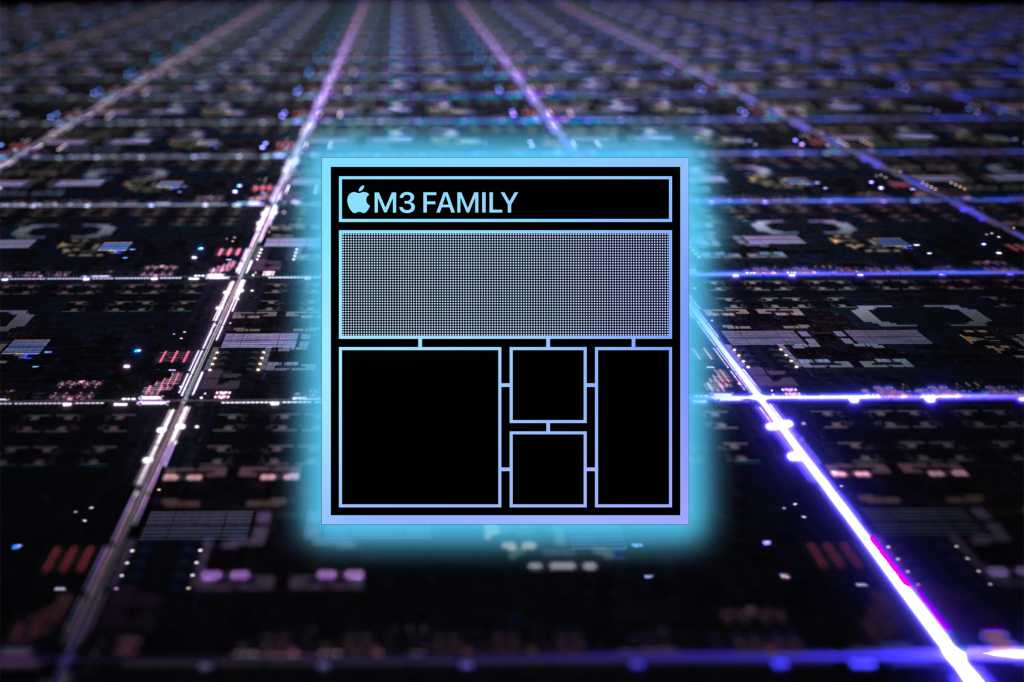I recently posted reviews of the new M3 iMac and the M3 Max 16-inch MacBook Pro, and I’ve seen interesting and insightful responses to Apple’s new Macs, both in my email and on social media. A frequent comment that struck me is the opinion that the M3 doesn’t provide enough of a boost over the M1 and M2.
Before the M3 came to market, speculation was that the new 3-nanometer fabrication process would allow for greater transistor density, thus resulting in a larger-than-usual performance boost. Or maybe people remember how big the M1 gains were during the switch from Intel, and they expect the same type of gains all the time now. Whatever the reason, expectations have been raised now.
But historically, the generational increase between chips has usually been about 15 to 20 percent. That was the case with Intel processors, and we’re now seeing that with Apple’s M-series. We’re getting incremental changes, so we’re getting incremental improvements.
Base M-series chips compared: Geekbench 6
Here are Geekbench 6 results for the three base M-series chips that Apple has released. The improvement is about 20 percent between each chip. The M3 doesn’t provide a bigger boost, to the disappointment of some. And chances are, we’re going to continue to see this type of improvement over the next few generations, until Apple performs a major architecture change, or some other technological development happens. That’s likely years away.
But there’s a different way to look at the progress of Apple chips and to see how users can benefit.
The M3 raises the performance bar
Here’s a different perspective on the M3 performance and how it compares to past chips. Spoiler: The chart below is flat; in other words, the chips have the same performance.
M3 vs M2 Pro
As you can see here, the M3 offers the same multi-core performance as the M1 Pro, M1 Max, and M2 Pro. The M3 is an 8-core CPU, while the others have 10 cores. That’s a significant performance indicator, one that’s not necessarily obvious.
What this chart also shows is that the $1,599 M3 MacBook Pro has the same performance value as the M2 Pro MacBook Pro sold for $1,999, and the M1 Pro/Max MacBook Pro which sold for over $2,000. I won’t go so far as to say that the base M3 now offers Pro-chip level performance, but what the base M3 effectively does is raise the bar.
M3 Pro vs M2 Max
This chart isn’t flat like the previous one. The performance differences are obvious, but there is much more happening in the background. Let’s get to the main point, first: The M3 Pro performs roughly the same as a M2 Max. On the surface, that leaves an impression–today’s Pro is yesterday’s Max.
But as I said, much more is happening here. Apple made the decision to change the CPU core layout of the M3 Pro. The 12-core version has a base M3-like core distribution, with an equal number of performance and efficiency cores (six each). That’s different from previous Pro chips that had more performance cores; the 10-core M1 Pro/Max had eight performance and two efficiency, and the 12-core M2 Pro and Max had eight performance and four efficiency.
So in a way, the M3 Pro is doing more with less. You could argue that Apple diminished the M3 Pro by giving it fewer performance cores—in fact, the 11-core M3 Pro has more efficiency cores (6) than performance cores (5)—but it doesn’t tell the whole story. The reasons for why Apple changed its Pro core layout are somewhat vague, citing customer research and application use. But it becomes obvious when you look at the M3 Max’s Geekbench scores.
M3 Max vs M2 Ultra
On the other side if the M3 coin, the M3 Max has 16 CPU cores, 12 of which are performance cores. That’s the most performance cores in an M-series chip except for the 24-core M2 Ultra, which has 16 performance cores. And the M3 Max’s CPU performance is equal to that of the M2 Ultra.
The jump in performance from Pro to Max is a lot more profound with the M3. This seems like a strategic move by Apple to get its pro customers to go with a Max and not settle for a Pro. It seems like it’s worth it.
The M3 Pro with a 40-core GPU in the MacBook Pro is the same $3,999 price as a Mac Studio with an M2 Ultra with a 60-core GPU–you can’t get the Ultra chip in a laptop. The Mac Studio beats the MacBook Pro in graphics performance, but that’s a desktop chip—and the laptop doesn’t disappoint. You get a lot of power in a portable.
What does this all mean?
Everyone knows that processors are always getting faster, but the fact of the matter is that for a lot of general consumers, Apple’s M1 chip is fast enough. So the disappointment comes when the speed increases are predictably incremental. For those who have an insatiable need for speed, the M-series development seems laggard.
But there’s more to it than that. Chips that are being issued now are not just replacing their older brethren on the same level, but one above it, as well. For example, today’s M3 Max bests the M2 Max and equals the M2 Ultra. You get a level-up for your money just a generation later.
Looking ahead, the time when an M-series base chip is as fast as today’s M2 Ultra chip is coming–and it may not be that far away. The gains might not be as blow-away as they were when the M1 arrived, but don’t sleep on the M3. You’re getting significantly more bang for your buck, and it’s only going to get better.

